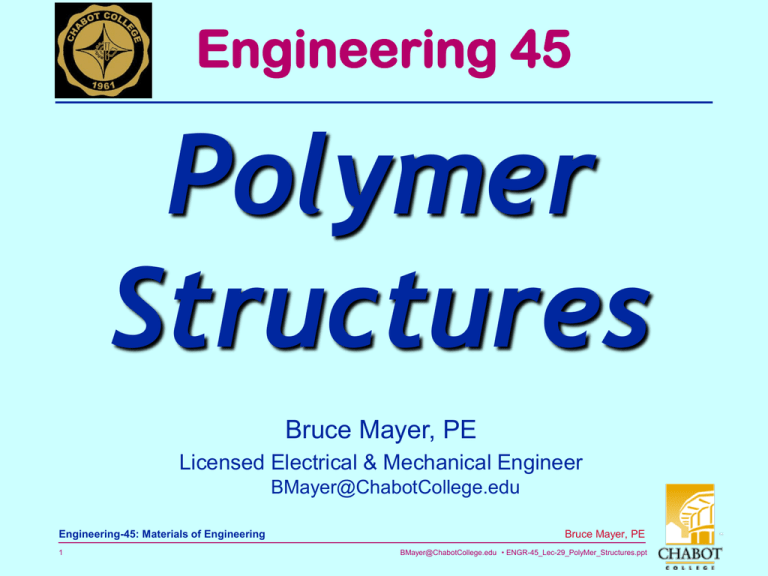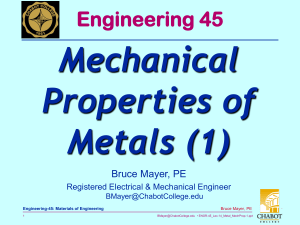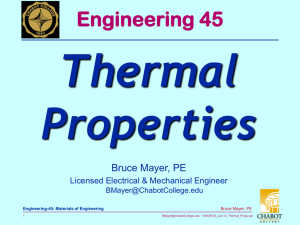WATKINS - Chabot College
advertisement

Engineering 45 Polymer Structures Bruce Mayer, PE Licensed Electrical & Mechanical Engineer BMayer@ChabotCollege.edu Engineering-45: Materials of Engineering 1 Bruce Mayer, PE BMayer@ChabotCollege.edu • ENGR-45_Lec-29_PolyMer_Structures.ppt Learning Goals – Polymer Structure Learn The Basic Electronic Structure of Very Long Organic Molecules Understand Basic MicroStructural Features of Polymers Calculate Molecular Weights for LongChain Polymers Learn the Difference between ThermoSETTING and ThermoPLASTIC Polymers Engineering-45: Materials of Engineering 2 Bruce Mayer, PE BMayer@ChabotCollege.edu • ENGR-45_Lec-29_PolyMer_Structures.ppt Ancient Polymer History Originally natural polymers were used • Wood, Cotton, Leather, Rubber, Wool, Silk Early Human-History Uses for the Natural PolyMers • Rubber balls used by Incas • Noah used pitch (a natural polymer) for Sealing the Ark Engineering-45: Materials of Engineering 3 Bruce Mayer, PE BMayer@ChabotCollege.edu • ENGR-45_Lec-29_PolyMer_Structures.ppt Organic Chemistry Recall PolyMer Many Mers Mer a Single Chemical Unit Almost All Solid Polymer Materials are “Organic” in Nature Organic → Based on CARBON Almost All Organic Chemicals are a combination of Carbon And HYDROGEN Engineering-45: Materials of Engineering 4 Bruce Mayer, PE BMayer@ChabotCollege.edu • ENGR-45_Lec-29_PolyMer_Structures.ppt C-H Bond ReCall from Periodic Table the Valences for C&H • C → Grp IVa → 4 Valence e− • H → Grp 1A → 1 Valence e− Thus in a C-H molecule Both can Attain the Noble-Gas Configuration if • 4 H’s Give their e−’s to 1 Accepting C Four-H’s and 1-C Yield the METHANE molecule Engineering-45: Materials of Engineering 5 Bruce Mayer, PE BMayer@ChabotCollege.edu • ENGR-45_Lec-29_PolyMer_Structures.ppt Single, Double, Triple Bonding First Note That the Methane Molecule is NOT Planer in 3D • As Might be Expected the H’s Take Equal Separation to Form a Tetrahedral Structure In Methane, Each H Atom Shares ONE e− • This Configuration is Shown Schematically as H | H C H | H • Each C-H is connected by a SINGLE Bond as depicted the Single-Line Connection Engineering-45: Materials of Engineering 6 Bruce Mayer, PE BMayer@ChabotCollege.edu • ENGR-45_Lec-29_PolyMer_Structures.ppt 1X, 2X, 3X Bonding cont.1 Another Electronic Configuration, Ethylene, Has the two adjacent Carbons sharing TWO e− to achieve the Neon Configuration H | C H | H C C H C | | H H Engineering-45: Materials of Engineering 7 In this case the C=C connection is termed a DOUBLE Bond Similarly, in Acetylene two Carbons Share 3 e− to form a TRIPLE Bond Bruce Mayer, PE BMayer@ChabotCollege.edu • ENGR-45_Lec-29_PolyMer_Structures.ppt The C-H Chain Basic-Mer Consider the Base Methane Molecule with the end-H’s Removed H | C H | C H | C | | | H H H The Central Carbon Can Connect to Similar Fragments with a 1X Bond to form a CHAIN Engineering-45: Materials of Engineering 8 The CH2 Fragment, or Mer, can Repeat Almost endlessly, creating very large PolyMer Chain Molecules There can be Many basic Mers consisting of • 2X or 3X bonded C’s • Other Atoms, or Ions (Molecule Fragments) may Substitute for H Bruce Mayer, PE BMayer@ChabotCollege.edu • ENGR-45_Lec-29_PolyMer_Structures.ppt PolyMer MicroStructure Some Typical Repeating-Mer (PolyMer) Structures C-C Forms a Very Strong intRAmolecular Bond • The CoValent IntERmolecular Bond Strength Varies with the Form of the Chain-to-Chain Electronic interaction Direction of increasing strength Engineering-45: Materials of Engineering 9 Bruce Mayer, PE BMayer@ChabotCollege.edu • ENGR-45_Lec-29_PolyMer_Structures.ppt Mer Forms in 3D PE: polyethylene Phenol-formaldehyde (Bakelite) Engineering-45: Materials of Engineering 10 PVC: polyvinyl chloride PET: polyethylene terephthalate (a polyester) Bruce Mayer, PE BMayer@ChabotCollege.edu • ENGR-45_Lec-29_PolyMer_Structures.ppt Example → PolyEthylene Poly (many) Mer (parts): A large molecule made up of one or more repeating units (mers) linked together by covalent chemical bonds. The PolyEthylene Chemical Reaction n CH 2 CH 2 CH 2 CH 2 n Temp, Press • n = number of monomers reacting >> 1 Engineering-45: Materials of Engineering 11 Bruce Mayer, PE BMayer@ChabotCollege.edu • ENGR-45_Lec-29_PolyMer_Structures.ppt Effect of Molecular Weight on the Properties of PolyEthylene Engineering-45: Materials of Engineering 12 Bruce Mayer, PE BMayer@ChabotCollege.edu • ENGR-45_Lec-29_PolyMer_Structures.ppt PolyMer Chemistry Polymer MACROmolecules Produce NONcrystalline Solids by the interMolecular Bonding The Chain-Creating “PolyMerization” Chemical Reaction usually Proceeds with the aid of a catalyst, R monomers + catalyst (initiator) = polymer chain Poly Ethylene H polyethylene (C2H4 Mer) Engineering-45: Materials of Engineering 13 C Bruce Mayer, PE BMayer@ChabotCollege.edu • ENGR-45_Lec-29_PolyMer_Structures.ppt Molecular Geometry As indicated in the Previous Slide Any Three Carbons in the “BackBone” form Something near the Classic Tetrahedral Angle (109.471°) However the Molecules are NOT constrained to TWO Dimensions The BackBones can Rotate, Kink, or Coil to Generate Randomly Complex Shapes Engineering-45: Materials of Engineering 14 Bruce Mayer, PE BMayer@ChabotCollege.edu • ENGR-45_Lec-29_PolyMer_Structures.ppt Isomerism IsoMerism two compounds with same chemical formula can have quite different structures • Example: C8H18 – n Octane H H H H H H H H H C C C C C C C C H = H3C CH2 CH2 CH2 CH2 CH2 CH2 CH3 H H H H H H H H – 2-methyl-4-ethyl pentane (IsoOctane) CH3 H3C CH CH2 CH CH3 CH2 CH3 Engineering-45: Materials of Engineering 15 Bruce Mayer, PE BMayer@ChabotCollege.edu • ENGR-45_Lec-29_PolyMer_Structures.ppt Cross-linking Generally, amorphous polymers are weak. Cross-linking adds strength: vulcanized rubber is polyisoprene with sulphur-based cross-links: Engineering-45: Materials of Engineering 16 Bruce Mayer, PE BMayer@ChabotCollege.edu • ENGR-45_Lec-29_PolyMer_Structures.ppt PolyMer Size Characterization MOLECULAR WEIGHT, Mw Mass of a mol of chain-molecules Average CHAIN SIZE, n Number of Mers per Chain • Also Called the “Degree of PolyMerization” Some Consequences: Mw↑ Tmelt↑ • short chains (~100 g/mol): liquid or gas • long chains (1000 g/mol): waxy solid, soft resin • “high polymer” (>10,000 g/mol): solid Also Mw↑ TS↑ • Longer chains are entangled (anchored) better Engineering-45: Materials of Engineering 17 Bruce Mayer, PE BMayer@ChabotCollege.edu • ENGR-45_Lec-29_PolyMer_Structures.ppt MOLECULAR WEIGHT • Molecular weight, Mi: Mass of a mole of chains. Lower M higher M total wt of polymer Mn total # of molecules M n x i M i M w w i M i Mw is more sensitive to higher molecular weights Engineering-45: Materials of Engineering 18 Bruce Mayer, PE BMayer@ChabotCollege.edu • ENGR-45_Lec-29_PolyMer_Structures.ppt Molecular Weight Calculation Example: average mass of a class Ni Mi xi wi # of students mass (lb) 1 1 2 3 2 1 100 120 140 180 220 380 0.1 0.1 0.2 0.3 0.2 0.1 0.054 0.065 0.151 0.290 0.237 0.204 Σ=10 Σ=1860 Mn 186 lb Mw 216 lb Engineering-45: Materials of Engineering 19 M n xi Mi M w w i Mi Bruce Mayer, PE BMayer@ChabotCollege.edu • ENGR-45_Lec-29_PolyMer_Structures.ppt Tacticity isotactic – all R groups on same side of chain syndiotactic – R groups alternate sides atactic – R groups random Engineering-45: Materials of Engineering 20 H H H H H H H H C C C C C C C C H R H R H R H R H H H R H H H R C C C C C C C C H R H H H R H H H H H H H R H H C C C C C C C C H R H R H H H R Bruce Mayer, PE BMayer@ChabotCollege.edu • ENGR-45_Lec-29_PolyMer_Structures.ppt Cis/Trans IsoMerism cis Form CH3 H trans Form CH3 C C CH2 C C CH2 cis-isoprene (natural rubber) Bulky groups on same side of chain Engineering-45: Materials of Engineering 21 CH2 CH2 H trans-isoprene (gutta percha) bulky groups on opposite sides of chain Bruce Mayer, PE BMayer@ChabotCollege.edu • ENGR-45_Lec-29_PolyMer_Structures.ppt CoPolyMers Adapted from Fig. 14.9, Callister 7e. random Two or More MonoMers PolyMerized ToGether • random – A and B randomly vary in chain • alternating – A and B alternate in polymer chain • block – large blocks of A alternate with large blocks of B • graft – chains of B grafted on to A backbone Engineering-45: Materials of Engineering 22 alternating block B A graft Bruce Mayer, PE BMayer@ChabotCollege.edu • ENGR-45_Lec-29_PolyMer_Structures.ppt PolyMer Crystallinity % Crystalinity % of Material that is crystalline crystalline region amorphous region TS and E often increase with % crystallinity Annealing causes crystalline regions to grow. • % crystallinity increases Simulated conformation of a polymer chain consisting of 100 main chain repeat units and 50 side chains, each consisting of 20 repeat units. Engineering-45: Materials of Engineering 23 Bruce Mayer, PE BMayer@ChabotCollege.edu • ENGR-45_Lec-29_PolyMer_Structures.ppt PolyMer Xtals - Spherulites Polymer Single Xtals Often Form Plate-like, or Lamellar, Structures by Folding Back on themselves Lamellae Tie Molecules In Bulk Material, Amorphous regions of Twisted & Kinked “Tie Molecules:”connect the Lamellae Engineering-45: Materials of Engineering 24 Upon Heating the Layered Structures Become Spherical with an “OnionLayer”, or Spherulitic, Structure Bruce Mayer, PE BMayer@ChabotCollege.edu • ENGR-45_Lec-29_PolyMer_Structures.ppt ThermoPlastic 25 Polymer-Chain Structure v. Heating ThermoSetting Engineering-45: Materials of Engineering Bruce Mayer, PE BMayer@ChabotCollege.edu • ENGR-45_Lec-29_PolyMer_Structures.ppt ThermoPlastic Polymers Polymers which melt and solidify withOUT chemical change are called thermoplastics. They support hot-forming methods such as injection-molding Engineering-45: Materials of Engineering 26 Bruce Mayer, PE BMayer@ChabotCollege.edu • ENGR-45_Lec-29_PolyMer_Structures.ppt ThermoSet Polymers Polymers which irreversibly change when heated are called thermosets. Most often, the change involves cross-linking which strengthens the polymer (setting). Thermosets will not melt, and have good heat resistance. They are often made from multi-part compounds and formed before setting (e.g. epoxy resin) Setting accelerates with heat or, for some polymers, with UV light. Engineering-45: Materials of Engineering 27 Bruce Mayer, PE BMayer@ChabotCollege.edu • ENGR-45_Lec-29_PolyMer_Structures.ppt ThermoSets vs ThermoPlastics ThermoPlastics • little cross linking • ductile • Soften, then Melt with heating • Examples – polyethylene (PE) – Polypropylene (PP) – Polycarbonate (Lexan) – polystyrene (StyroFoam) Engineering-45: Materials of Engineering 28 ThermoSets • large cross linking – 10 to 50% of mers • hard and brittle • do NOT soften with heating – Decompose Instead • Examples: vulcanized rubber, epoxies, polyester resin, phenolic resin • 1st Synthetic Polymer Bruce Mayer, PE BMayer@ChabotCollege.edu • ENGR-45_Lec-29_PolyMer_Structures.ppt WhiteBoard Work Prob 14.9 • For the Kinked & Twisted Polymer at right Find – Total Length, L – End-to-End distance, r • Given – Eqns 14.11 & 14.12 – Mn for Linear PolyPro = 300 kg/mol Simulated conformation of a polymer chain consisting of 100 main chain repeat units and 50 side chains, each consisting of 20 repeat units. Engineering-45: Materials of Engineering 29 Bruce Mayer, PE BMayer@ChabotCollege.edu • ENGR-45_Lec-29_PolyMer_Structures.ppt Appendix - BakeLite The First Synthetic Polymer Invented by Leo Beakeland (1863 - 1944) in 1907 in Yonkers, NY Chemical Name → phenol formaldehyde (Phenolic) Historic Products • 1912 - A Bakelite record invented by Edison. (USA) • 1912 - Bakelite billiard balls invented by Hyat Burroughs. (UK) • 1914 - The telephone receiver made of Bakelite by Western Electric. (USA) • 1915 - Photo camera from Kodak by Eastman gets a Bakelite case. (USA) • 1923 - Philips radio company starts with its own Bakelite production, called Philite. (Netherlands) • 1926 - First Bakelite chair • 1927 - First Philite radio speaker made by Philips. (Netherlands) – See also http://www.mbzponton.org/valueadded/maintenance/bakelitehist.htm Engineering-45: Materials of Engineering 30 Bruce Mayer, PE BMayer@ChabotCollege.edu • ENGR-45_Lec-29_PolyMer_Structures.ppt







